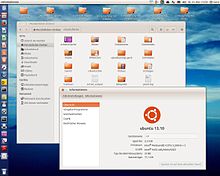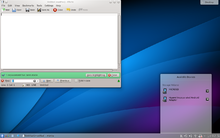Desktop (graphical user interface)

The desktop (composed of English. Desk for desk and top of its surface) is in the computer the bottom (or rearmost / last) window plane of a desktop environment . In terms of metaphor, it not only contains closed documents (files), but also the documents (windows of the programs) opened. In multi-user systems, each user profile has its own desktop folder in the profile folder.
In German, the term “desktop” is mostly used (default for Windows), common synonyms are “desk” (macOS, Linux) or “work surface” (Linux).
Desk metaphor
The desktop forms the basis of the so-called desk metaphor . As a rule, several icons ( pictograms ) can be arranged on the desktop . Common desktops often contain symbols such as hard drive partitions , removable media and the recycle bin , as well as any shortcuts to files and folders or even files and folders themselves.
The technical implementation of the desk metaphor takes place in a desktop environment . Desktop Environment .
The desk metaphor was developed in the 1970s at the Palo Alto Research Center by Xerox , then a manufacturer of copiers, printers, etc. Ä. Solutions, mainly developed by Alan Kay . It was first known to a wide audience with the Macintosh and is now an integral part of many graphical user interfaces , such as:
- Windows has been using the Modern UI since Windows 8, which replaced Aero from Windows Vista and 7 ; before that z. B. Luna the UI of Windows XP
- Aqua from macOS
- u. a. KDE Plasma , Gnome , Xfce and LXDE under Unix (like BSD ) or Linux
- Series 60 on various cell phones under Symbian
In many implementations, the desktop itself or substantial parts of it are represented by an excellent directory for the user. Under KDE, GNOME, macOS and Windows it is the user's “Desktop” directory.
There are also graphical interfaces that are referred to as desktops and yet do not use a desk metaphor. An X server with a simple window manager like twm does not have any of the icons mentioned above, but does have a background layer that can be referred to as the desktop. Instead of symbols, KDE Plasma 4 and 5 supports mini programs ("plasmoids") on the work surface, which in turn can display the contents of the desktop directory (and others), thereby simulating (or expanding) the "classic" behavior of other desktops can.
In the graphical user interface GEM from Digital Research , which was also part of the TOS operating system of the Atari ST computer (1985), the graphical shell was called the desktop , the program was also called "DESKTOP.APP" internally. In the Amiga, on the other hand, it was called Workbench , because software tools were used on this workbench.
Virtual desktop
A virtual desktop is a desktop whose area is larger than the area of the display screen. The extended area can be made accessible by scrolling or switching.
3D desktop
Various concepts are used to design a desktop for the purpose of clarity, simple navigation with just a few mouse clicks, ergonomics, etc. One such concept is the 3D desktop. The user is fooled into a 3D world, which is actually displayed on the two-dimensional screen. The 3D display can be used, for example, to move and rotate 3D objects or to offer different desktop views. Examples of frequently used 3D desktops are KDE 4 and Compiz .


